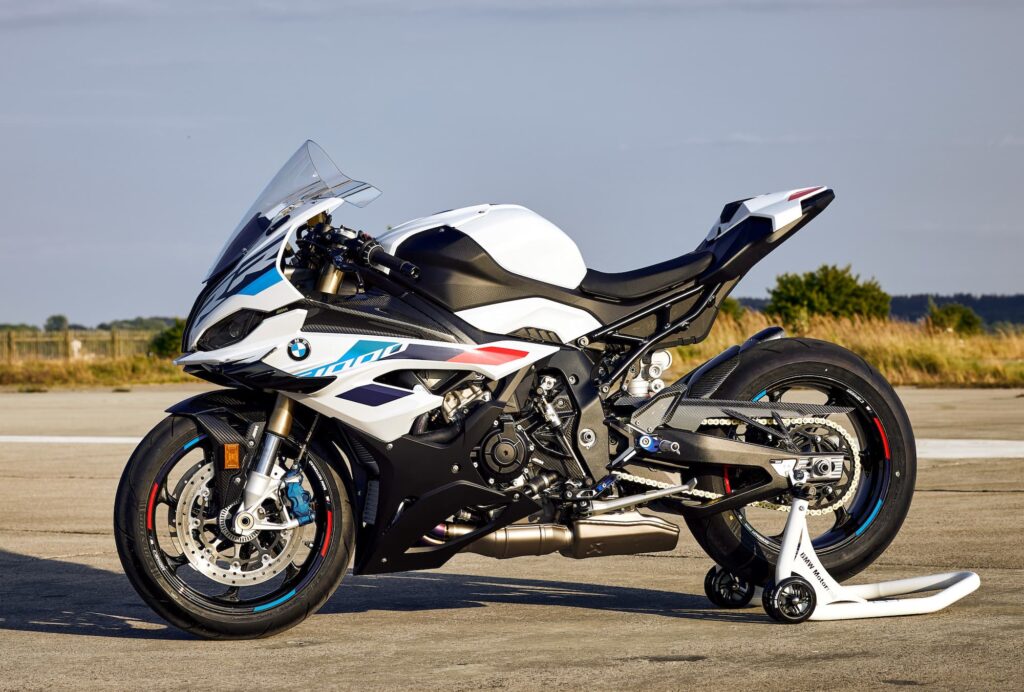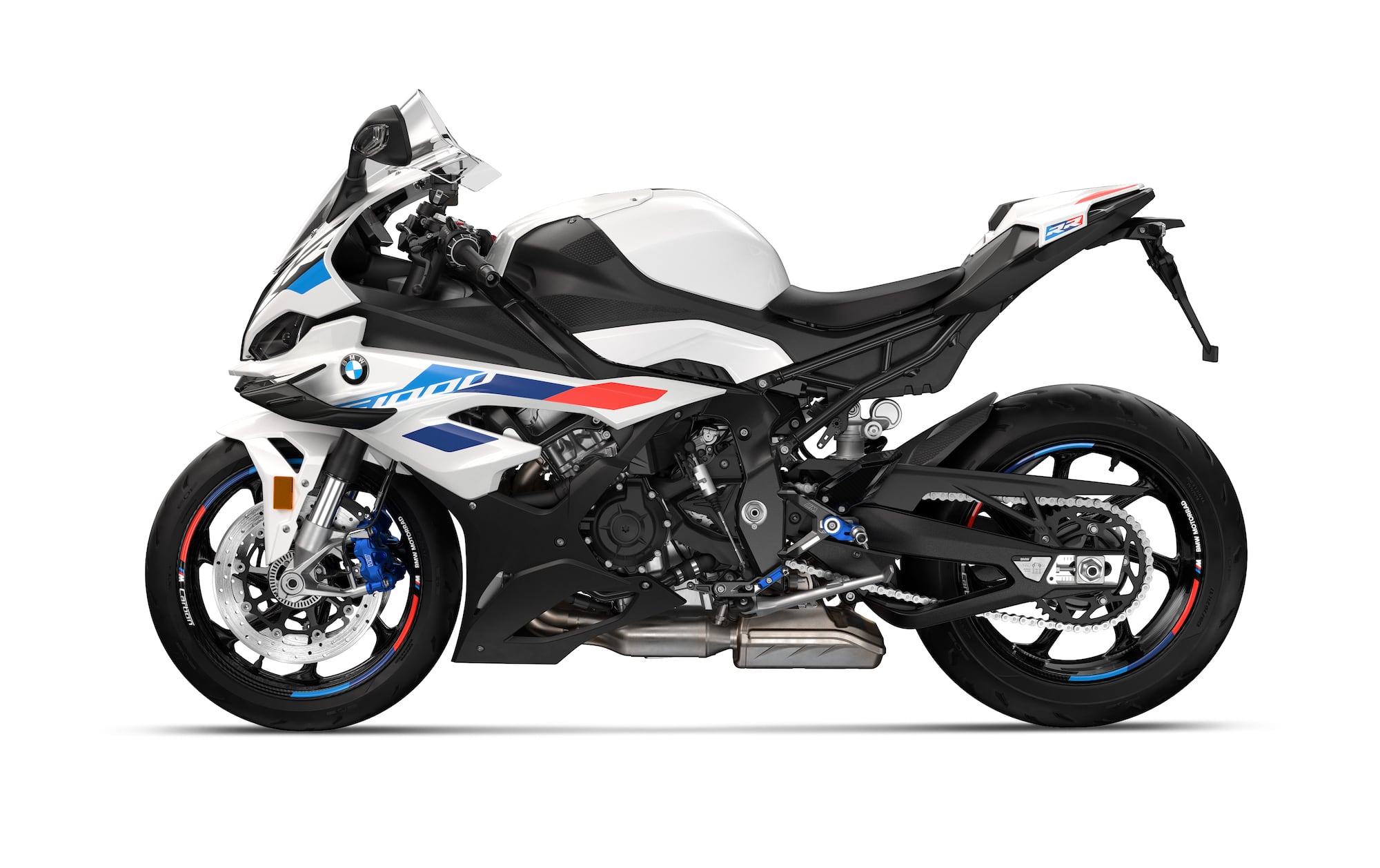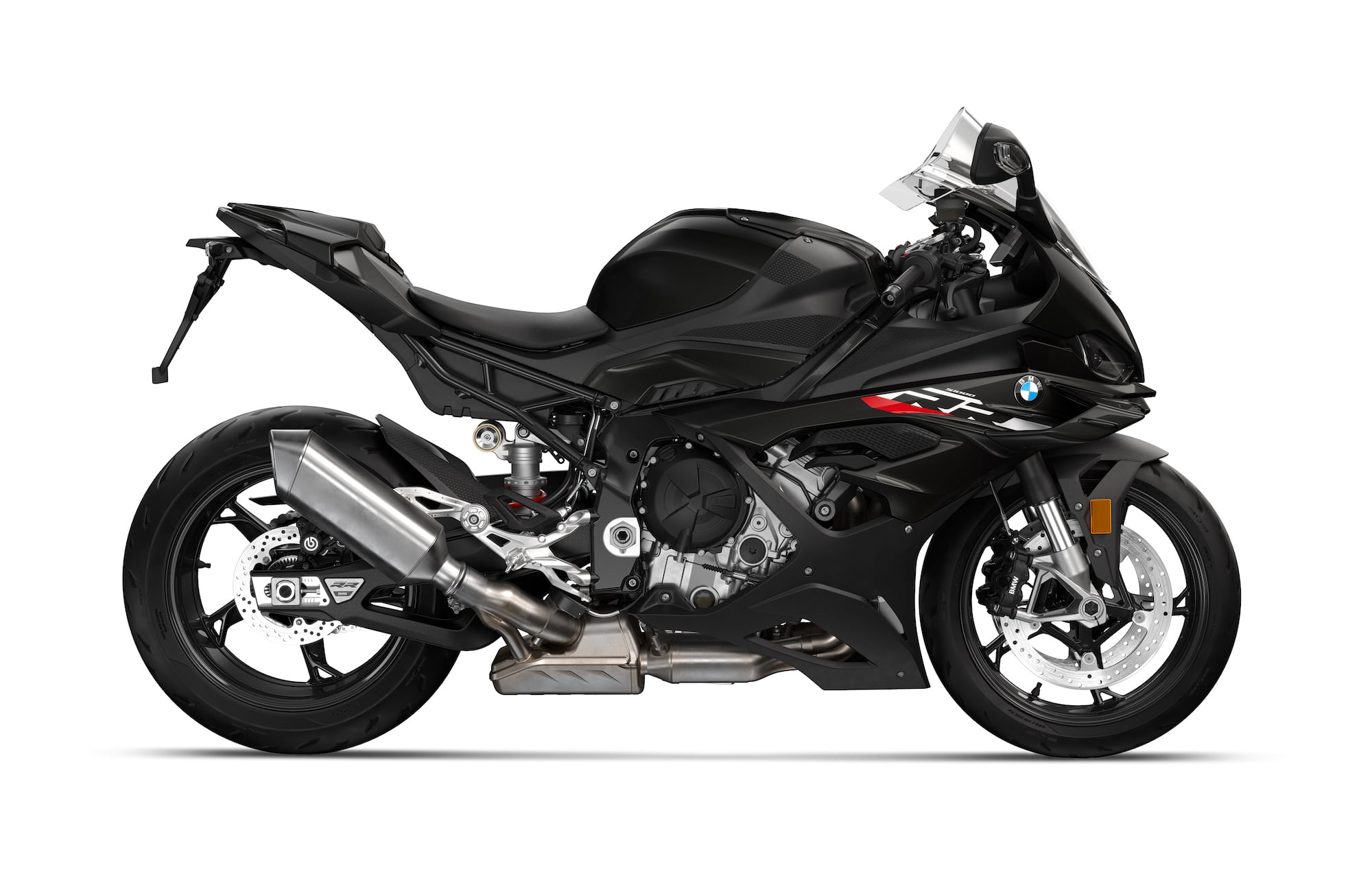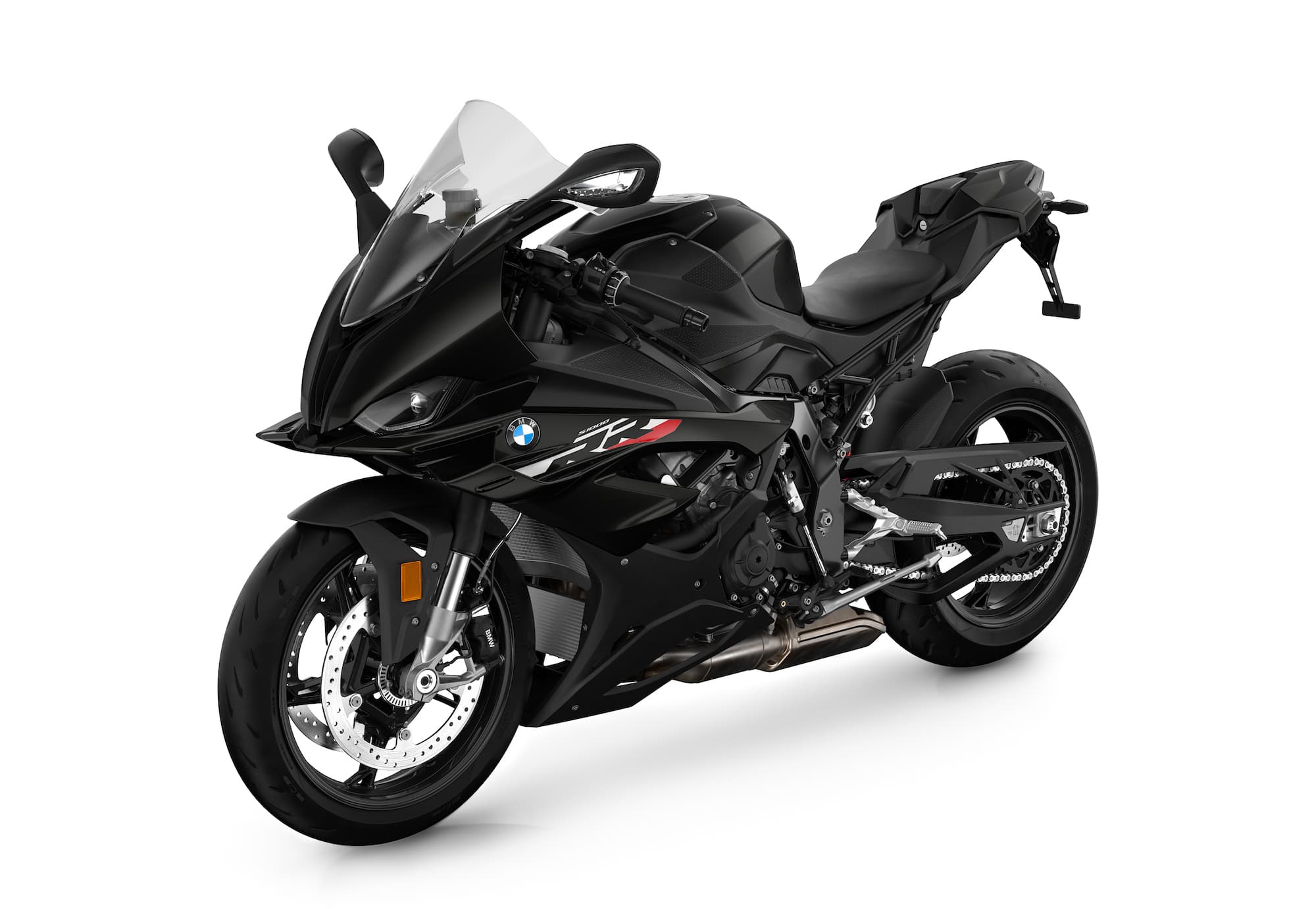BMW S 1000 RR (Gen 5, 2023+) Maintenance Schedule / Service Intervals
This is the maintenance schedule and service intervals for the 2023+ BMW S 1000 RR, also known as the S1000RR or just S1KR among fans. The following is from the manual as well as from other resources online.
BMW updated the S 1000 RR for 2023 in September 2022 (see here for the official press kit). The S 1000 RR continues in the same vein as previous model BMW S 1000 RR superbikes — it’s still a kick-ass track / street sport motorcycle with an inline four-cylinder engine that makes over 200 horsepower. In the latest spec, the 999 cc engine makes peak power of 154 kW / 210 hp at 13750 rpm (a slight bump over the last model), thanks to the updated ShiftCam engine.
The maintenance schedule shares a lot with the previous generation BMW S 1000 RR made from 2019 to 2022. The engine was overhauled, and many parts changed, but the maintenance schedule is similar. BMW did update some requirements though, like the annual service requirement, and added some details to the annual service checklist.
Here are all the maintenance schedules for the BMW S 1000 RR and related HP4 models:
This site has links for things like oil and spark plugs from which we earn a commission (which unfortunately nobody can save, not even us). If you appreciate this work, then please use those links. Thanks!
Service Intervals for the BMW S 1000 RR
Overall, the BMW S 1000 RR has 6000 mile / 10000 km and annual service intervals.
At every annual service interval, do the standard annual service — this means a lot of checks for leaks, smooth operation, and correct fluid levels, as well as functioning safety equipment (brakes, lights, etc.). As of 2023, BMW recommends you do the annual service also at 6000 mile / 10000 km distance intervals, which makes sense to retrospectively apply to older models.
At every service (either at the distance or time interval), change the oil and filter.
Every 18000 miles or 30000 km, do a major service, including replacing the spark plugs, checking the valve clearances, checking engine timing, and changing the fork oil.
Also make sure you keep the brake fluid fresh — it should be replaced at least every two years, or more often if you use your S 1000 RR aggressively.
BMW doesn’t specify a coolant service interval, instead recommending dealers check its effectiveness and change it when it diminishes.
What you need to service the BMW S 1000 RR — Consumables and Special Tools
If you’re servicing the S 1000 RR, you at least need motorcycle maintenance tools — things like an oil catch pan, a paddock stand, and so on, plus the following specific consumables.
| Part | BMW S 1000 RR spec (2023+) |
|---|---|
| Engine oil | Per the manual, you need 4.5L of SAE 5W-40, API SJ/JASO MA2. Additives (for instance, molybdenum-based substances) are prohibited, because they would attack the coatings on engine components. BMW Motorrad recommends BMW Motorrad Advantec Ultimate 5W-40. An alternative is Castrol Power RS 5W-40. |
| Oil filter | All BMW S 1000 RR bikes use a BMW/Mahle oil filter, part number 11 42 7 721 779. You can also use a HF160RC. |
| Engine coolant | BMW recommends Frostox HT-12 (see here for alternatives), with minimum 50% mixed with pure demineralised (not tap, not mineral) water. It’s based on ethylene glycol. |
| Spark plugs | NGK LMAR9FI-10G. This is what the manual suggests. |
| Air filter | You can get the stock air filter (part 13 72 9 444 643), but riders love the maintenance-free Sprint air filter for the BMW S 1000 RR (Part number PM171S). |
| Brake/clutch fluid | BMW prefers their own BMW DOT 4 fluid, but any is fine — Castrol DOT 4 synthetic is high-quality and well-liked. |
| Brake pads | Use the standard brake pads by Brembo, which you can order from your dealer (part 34 11 8 405 104 for the front, and 34 21 7 722 884 for the rear). Or use EBC double H brake pads, a double set of FA724HH for the front, and FA213HH for the rear. |
| Chain lube | Use Motul chain paste. |
| Cable lube | For lubricating control cables, use Protect all cable life. |
Maintenance schedule for the 2023+ BMW S 1000 RR
Below is the maintenance schedule for the S 1000 RR. It’s subtly different from the previous gen.
The schedule below is the same as in the 2023+ BMW S 1000 RR’s manual, but simplified for display on the screen and ease of interpretation.
Notes
- Past the end of the indicated service schedule, continue in the pattern shown.
- When there’s a time or distance-based interval, do the service at the earlier of the two. E.g. do the annual service and oil change every 6000 miles / 1000 km or year.
| km x 1000 | 10 | 20 | 30 | |
|---|---|---|---|---|
| mi x 1000 | 6 | 12 | 18 | Every |
| Perform standard annual service checklist (see below) | ✓ | ✓ | ✓ | Year |
| Change engine oil and filter | ✓ | ✓ | ✓ | Year |
| Replace air filter | ✓ | ✓ | ✓ | |
| Check valve clearances | ✓ | |||
| Check the engine timing | ✓ | |||
| Replace all spark plugs | ✓ | |||
| Change oil in telescopic forks | ✓ | |||
| Change brake fluid in entire system | After 1 year, then every 2 years |
Standard Annual Service Checklist
Below are the items you should do in your standard annual service for the BMW S 1000 RR. Note that this has been updated in 2023 with a few different line items.
| Standard annual service |
|---|
| [Dealer] Perform the vehicle test with BMW Motorrad diagnosis system |
| Visually inspect the brake lines, brake hoses and connections |
| Check front brake pads and brake discs for wear |
| Check the front wheel brake fluid level |
| Check rear brake pads and brake disk for wear |
| Check the rear wheel brake fluid level |
| Check the steering-head bearing for smooth operation |
| Check the coolant level |
| Check the clutch cable and clutch lever play. Lubricate as necessary |
| Check and lubricate the chain drive |
| Check the tire pressures and tread depth |
| [If fitted] Check the carbon wheels for damage, cracks, and other wear |
| Check the side stand for ease of movement. Lubricate as necessary (Lithium soap-based grease) |
| Check the lighting and signal system. |
| Check that the engine starting suppression works. |
| Perform final inspection and road safety check |
| [Dealer] Set the service date and remaining distance to service using the BMW Motorrad diagnostic system |
| Check charging state of battery |
| [Dealer] Confirm the BMW Service in the on-board literature. |
Maintaining the BMW S 1000 RR’s Chain Sag / Deflection
It’s important to regularly check the chain wear and sag. BMW recommends checking the chain sag and wear, and lubricating the chain every third refuelling stop, which is roughly every 400 miles / 600 km. But you should do it more frequently if you ride your bike aggressively (e.g. at track), or if it gets dirty or wet, or after you wash your motorcycle.
See the below reference for checking chain sag on the BMW S 1000 RR.

On the BMW S 1000 RR, you measure chain sag by measuring the total deflection of the chain when the middle part of the bottom segment is pushed up.
Target chain sag on BMW S 1000 RR: 45-50 mm (1.75 – 2 inches)
Measure the sag when its on its side stand, with no weight on the bike. It should be on a level surface.
If the chain sag is out of spec, you neex to adjust it.
- Loosen the quick-release axle nut
- Loosen the lock nuts left and right.
- Use the adjusting nut to adjust chain sag. Make sure you adjust them to the same degree to keep the chain aligned. Use the reference markers.
- Tighten the lock nuts to 19 Nm / 12 lb-ft.
- Tighten the axle nut, using thread lock, to 125 Nm / 90 lb-ft.
- Check the chain sag again.
You should also check the chain length which is a way of measuring the wear. It can get stretched beyond a maximum permissible length.
The maximum permissible length is 144 mm measured between the center of 10 rivets, with the chain pulled taut. If it’s beyond this length, you need to replace the chain and sprockets.
Tyres [tires] and tyre pressures for the BMW S 1000 RR
The BMW S 1000 RR ships with the following tyre sizes and pressures.
Of course, the pressures are optimised for longevity and a standard weight — adapt them as you will.
| Wheel | Tyre size | Tyre pressure (cold) |
|---|---|---|
| Front | 120/70 ZR 17 (58) | 36 psi (2.5 bar) |
| Rear | 190/55 ZR 17 (75) M carbon/forged wheels: 200/55 ZR 17 | 42 psi (2.9 bar) |
About the 2023+ BMW S 1000 RR

The 2023+ BMW S 1000 RR is the latest in the line of BMW superbikes that took the world by storm since 2009.
The history of the BMW S 1000 RR is quite well known by know, but essentially, until 2009, BMW was mostly known for somewhat unorthodox sport motorcycles.
For sport bikes, they were trying their hardest to make it work with the boxer twin, the latest (and last) effort being the BMW HP2 Sport based around the twin cam motor. Actually, that was the debut for the twin cam.
At the time, BMW also made high-performance four-cylinder engines. But these were a bit unorthodox too — high-power, but with shaft drives at the rear, and a riding position and feature kit that made it clear that these bikes were designed for distance riding at speed, not performance at the track.
BMW drew its inspiration for the S 1000 RR from the K5 Gixxer (the Suzuki GSX-R1000 in 2005, for those not privy to that zeitgeist). This was a bike widely acknowledged as being a beast both on the track and for everyday riding. BMW had their sights set on the track, but they wanted to make a versatile machine, as they always had tried to do.
The first BMW S 1000 RR was a smash hit. Powerful, agile, and highly technologically capable, it does that BMW magic of making fast riding easy.
Successive version were all just as good, and kept improving.
BMW has continually added the latest technology to their S 1000 RR line. They’ve been first or near-first with lots of things including cornering ABS and active suspension.
One thing that has always made the S 1000 RR unique is the level of luxury in what’s still a lightweight, high-performance track machine. All of them have come standard with not just cruise control, but even heated grips!
For the 2023 model year, BMW has updated the motorcycle again. They take the same formula of a high-peformance inline four-cylinder superbike, with fundamentally the same engine underneath.
But BMW has added bits to make sure that they can keep up with the Joneses. For 2023, BMW added Brake Slide Assist and DTC Slide Control, helping the bike feel even more under control when at a track at high speed.
The engine has been re-tuned slightly but still makes similar power of over 200. The peak engine speed is 1400 rpm.
The new 2023+ BMW S 1000 RR also get swinglets — straight from the M RR. These will trickle down to most other bikes soon, I’m sure!

Aside from those minor technical changes, BMW did make changes to the maintenance schedule, which is why this model year is posted separately.
Reference — Manual for the BMW S 1000 RR (2023+
The above maintenance schedule came from the user manual for the 2023 BMW S 1000 RR.

You can download BMW user manuals directly from the website here. The manual is here but this link may go out of date.













